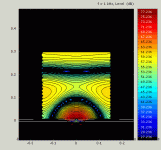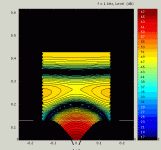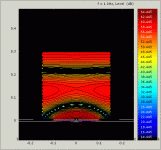I didn't read that thread but the thing is, when it comes to room response in the modal region it is not about directionality. It is about how the sources couple to the room. Ultimately, be they dipoles, monopoles or cardioids, they are all equivalent to multiple monopole sources distributed around the room, in or out of phase, with or without delay.
Ok - in a relatively small room there's usually is not too much room left to distribute woofers "all over the place" - so for the moment the 15" spaced by roughly 1m one behind the other and an other set to come and being placed 2m elevated (making eight 15" in total) should / must do .....
Michael
More likely the front and rear are both dipole sin phase, used to increase SPL in a somewhat compact package.
Remember that when you get to a 2nd order gradient system excursion goes like (1/f)^4. So over 1 octave excursion goes up by a factor of 16.
we can not hope for some room pressurization from the 2OG arrangement as is for the "true" cardioide bass - im afraid ?
(Don't see any net volume displacement...)
Michael
we can not hope for some room pressurization from the 2OG arrangement as is for the "true" cardioide bass - im afraid ?
(Don't see any net volume displacement...)
Michael
Agreed, no pressurization.
... when it comes to room response in the modal region it is not about directionality. It is about how the sources couple to the room. Ultimately, be they dipoles, monopoles or cardioids, they are all equivalent to multiple monopole sources distributed around the room, in or out of phase, with or without delay.
Hi John
I don't know if I had anything to do with this, but I am glad to see that someone else is realizing the situation with LFs in rooms and the fact that free field directionality has no meaning in a modally dominated situation.
I didn't read that thread but the thing is, when it comes to room response in the modal region it is not about directionality. It is about how the sources couple to the room. Ultimately, be they dipoles, monopoles or cardioids, they are all equivalent to multiple monopole sources distributed around the room, in or out of phase, with or without delay.
If we talk about steady state response, this is true. However, low frequency content is not so continuous when playing music, that is why there will be an audible difference based on how the modes are excited and decay.Hi John
I don't know if I had anything to do with this, but I am glad to see that someone else is realizing the situation with LFs in rooms and the fact that free field directionality has no meaning in a modally dominated situation.
If we talk about steady state response, this is true. However, low frequency content is not so continuous when playing music, that is why there will be an audible difference based on how the modes are excited and decay.
Well, here we go again... How long is "low frequency content" "when playing music" and how long does it take low frequency waves to "reflect" at room boundaries and become part of what is heard? The relation of a sound's wavelength to its delayed reflection within an acoustically small room is crucial to our hearing.
Markus
Last edited:
If you want to know how long low frequency content is in music, just use a spectrum display software. This is something you can see yourself. So, can you describe how wavelength and it's delayed reflection changes what we hear by using a specific musical instrument as an example?Well, here we go again... How long is "low frequency content" "when playing music" and how long does it take low frequency waves to "reflect" at room boundaries and become part of what is heard? The relation of a sound's wavelength to its delayed reflection is crutial to our hearing.
Markus
If you want to know how long low frequency content is in music, just use a spectrum display software. This is something you can see yourself. So, can you describe how wavelength and it's delayed reflection changes what we hear by using a specific musical instrument as an example?
I think you are missing the point. Stop and think. A monopole is a source that radiates uniformly in all directions in the free field. A dipole is two monopole sources, out of phase, that radiate in a figure 8 pattern in the free field, at great distance form the sources. A cardioid is two monopole sources, out of phase with a delay added to one source, that radiates a cardioid pattern in the free field at great distance.
Now take them and place them in a room. Let's consider 4 monopole sources. We can place them in the room as pairs, and depending on how we place them and how we drive them we can have two pairs of monopoles, two pairs that would be dipoles in free space, or two pairs of free space cardioids. But from the modal analysis or in room point of view what we have is six monopoles placed around the room operating with different phase and delay. There is no doubt that the different positioning and connections will result in different frequency response because the different setups, however you label them, excite the room modes differently. And given that the room/source system is still fundamentally a linear, time invariant system, there is a one to one correspondence between the frequency response measured at any point in a room and the impulse, or transient response at that point. It isn't so much that a dipole excites different modes because of the free space radiation pattern as it is that arranging two monopoles on a room so that they form a dipole excites modes differently than if they are positioned and connected in another arrangement. That's kind of a circular argument, but I think you will get the point. In a room, at low frequency the different formats are really nothing more that different arrangements of multiple monopoles.
Sound like you have no answer for my audible difference question either. So there are lots more people stuck in something. I just differentiate between different situations. meaning I believe in both Transient and Steady as they differ.If you can't answer my question then you'll be stuck in your LF-transient-response-belief forever.
Sound like you have no answer for my audible difference question either. So there are lots more people stuck in something. I just differentiate between different situations. meaning I believe in both Transient and Steady as they differ.
There's nothing to believe in. Just look at the facts but you don't seem to be willing to do that, although others with greater knowledge and objective arguments are very patient in explaining the facts over and over to you.
John, this part I agree with and understand. The part that I think most people miss is different directivity characteristics will excite a room differently for a fixed location. I will see if I can get some kind of simulation running with AxiDriver.I think you are missing the point. Stop and think. A monopole is a source that radiates uniformly in all directions in the free field. A dipole is two monopole sources, out of phase, that radiate in a figure 8 pattern in the free field, at great distance form the sources. A cardioid is two monopole sources, out of phase with a delay added to one source, that radiates a cardioid pattern in the free field at great distance.
Now take them and place them in a room. Let's consider 4 monopole sources. We can place them in the room as pairs, and depending on how we place them and how we drive them we can have two pairs of monopoles, two pairs that would be dipoles in free space, or two pairs of free space cardioids. But from the modal analysis or in room point of view what we have is six monopoles placed around the room operating with different phase and delay. There is no doubt that the different positioning and connections will result in different frequency response because the different setups, however you label them, excite the room modes differently. And given that the room/source system is still fundamentally a linear, time invariant system, there is a one to one correspondence between the frequency response measured at any point in a room and the impulse, or transient response at that point. It isn't so much that a dipole excites different modes because of the free space radiation pattern as it is that arranging two monopoles on a room so that they form a dipole excites modes differently than if they are positioned and connected in another arrangement. That's kind of a circular argument, but I think you will get the point. In a room, at low frequency the different formats are really nothing more that different arrangements of multiple monopoles.
John, this part I agree with and understand. The part that I think most people miss is different directivity characteristics will excite a room differently for a fixed location. I will see if I can get some kind of simulation running with AxiDriver.
Already did that here.
free field directionality has no meaning in a modally dominated situation.
I'm always wondering if the wording "modally dominated" is really appropriate because the number of modes is increasing with frequency.
Best, Markus
I have yet to see real measured data that shows the fact you are talking about. Does anyone have this? A dominat room mode excited by sources of distinctly different directivity?There's nothing to believe in. Just look at the facts but you don't seem to be willing to do that, although others with greater knowledge and objective arguments are very patient in explaining the facts over and over to you.
I'm always wondering if the wording "modally dominated" is really appropriate because the number of modes is increasing with frequency.
Best, Markus
Yes, poorly worded. "Modally challenged" might be the more politically correct phase.
What I meant was the region where modal effects dominate. Once the density gets high enough then the modal effects go away.
One of my pet pieves from when I worked for a large company was the CAE analysts who did massive simulations and produced volumes of beautiful pictures and graphs, but had no idea what it all meant or what to do with it.
What in the world are these pictures all about? Is this the answer to global warming or a new DNA molecule that will cure rickets? Based on what I've seen it could be either.
What in the world are these pictures all about? Is this the answer to global warming or a new DNA molecule that will cure rickets? Based on what I've seen it could be either.
Heh, I can relate to that. When I just got out of school, I watched people try to adjust a control system gain without knowing exactly what they were adjusting.
These graphs show the pressure distribution of an area excited by different pressure wave front shape as occurs in different directivity for a single frequency. Each contour line is an equal-pressure line. since this area is a square area, the modes in two directions would be the same. So what we eventually see is that if the pressure wave front is like emerging from a point source, then it starts to excite the lateral mode; if the pressure wave front is like emerging from a piston source, the the lateral mode is not so easily excited.
These graphs show the pressure distribution of an area excited by different pressure wave front shape as occurs in different directivity for a single frequency. Each contour line is an equal-pressure line. since this area is a square area, the modes in two directions would be the same. So what we eventually see is that if the pressure wave front is like emerging from a point source, then it starts to excite the lateral mode; if the pressure wave front is like emerging from a piston source, the the lateral mode is not so easily excited.
- Home
- Loudspeakers
- Multi-Way
- Beyond the Ariel


